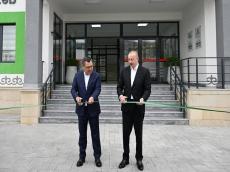By Elnur Enveroglu
In the aftermath of nearly three decades of occupation and
destruction, the village of Khidirli in Azerbaijan’s Aghdam
district is rapidly transforming into a symbol of national
resilience and renewal. Once reduced to rubble by Armenian forces,
Khidirli is now witnessing a historic rebirth, one shaped by
high-speed reconstruction, strategic investment in human capital,
and meaningful international partnerships. At the heart of this
transformation stands a joint initiative led by Azerbaijani and
Kyrgyz presidents, Ilham Aliyev and Sadyr Japarov, who on 3 July
inaugurated a state-of-the-art school and kindergarten in the
village. This is not merely a ceremonial gesture; it marks the
crystallisation of Azerbaijan’s broader vision for its liberated
territories.
What makes this initiative remarkable is not only its pace but
its scope. The reconstruction of Khidirli is part of a nationwide
effort to breathe life back into war-torn regions, where entire
communities were displaced and infrastructure annihilated. Thanks
to the decisive victory of the Azerbaijani Army under President
Aliyev’s leadership, such areas are now being restored with
precision, care, and long-term vision. Khidirli is emblematic of
this policy.
The village’s redevelopment is proceeding in structured phases.
More than 400 hectares have been allocated for the project, with
over 6,000 people expected to resettle there. In the first phase
alone, 719 houses have already been constructed, accompanied by a
comprehensive network of social and administrative services — from
healthcare units and guesthouses for visiting professionals to a
multifunctional community centre. Importantly, around 20 per cent
of the territory is set aside for green space, reflecting a
sustainability-minded approach that is becoming a hallmark of
Azerbaijan’s rebuilding process.
Yet it is the educational infrastructure of Khidirli that truly
sets the tone for its future. On 3 July, the village welcomed two
flagship institutions: the Aykol Manas Secondary School and a
nursery-kindergarten, both opened by Presidents Aliyev and Japarov.
These are not ordinary public buildings. They represent a strategic
bet on the youth of Karabakh, and an investment in the civic,
intellectual, and emotional rehabilitation of a traumatised
The school spans five blocks and includes 21 classrooms,
cutting-edge laboratories, ICT rooms, and even a military
preparation room, an indication of the civic and patriotic
dimensions of Azerbaijan’s educational priorities. The inclusion of
large sports grounds and recreational facilities also reflects a
child-centric approach to education, ensuring pupils are nurtured
both physically and mentally. The 2.7-hectare site is designed to
serve not only students but the wider community, supporting the
notion that schools should act as hubs of local regeneration.
Equally impressive is the new nursery-kindergarten, which is
already accommodating 120 children. Equipped with music and sports
rooms, landscaped play areas, and rooftop solar panels, the
facility combines functionality with innovation. It ensures
children in liberated areas are not deprived of the early-years
education opportunities available in the rest of the country.
Moreover, its sustainable design showcases a forward-thinking
approach to rebuilding, one that respects environmental
responsibility while addressing urgent human needs.
The involvement of President Sadyr Japarov of Kyrgyzstan in
these inaugurations underscores the emerging regional solidarity
that Azerbaijan is cultivating as it reshapes Karabakh. This
partnership serves a dual purpose: reinforcing diplomatic ties
within the Turkic world and providing international visibility to
Azerbaijan’s post-war reconstruction efforts. Japarov’s presence is
more than symbolic — it signals growing regional recognition of
Azerbaijan’s leadership in integrating innovation, education, and
community development into its recovery narrative.
What distinguishes Azerbaijan’s efforts in Khidirli is the clear
rejection of a minimalist or merely functional approach to
reconstruction. The government is not simply rebuilding what was
lost — it is laying the groundwork for a stronger, smarter, and
more self-reliant society. And it is doing so with remarkable speed
and discipline. Since the liberation of the region, dozens of
infrastructure projects have been launched, and thousands of
families are being prepared for a dignified return to their
In essence, the story of Khidirli reflects the national ethos
that has guided Azerbaijan’s post-war recovery: dignity through
development. Education, sustainability, and social cohesion are not
abstract goals — they are being materialised in bricks, wires,
solar panels, and lesson plans. This is the blueprint for peace:
not just ceasefire lines, but meaningful reintegration through
jobs, schools, homes, and a sense of belonging.
President Ilham Aliyev’s strategy of pairing physical
reconstruction with a human development agenda is particularly
significant. It ensures that the future of liberated areas is not
dictated by past suffering but driven by opportunity. In this
context, the Khidirli project is more than just a model for
post-conflict recovery in Azerbaijan. It sets a standard for how
nations can rebuild after trauma, not just restoring
infrastructure, but regenerating hope.
As the second phase of resettlement in Khidirli unfolds and more
families return to a village once buried under the scars of war,
the success of this project will likely echo far beyond Aghdam. It
will serve as proof that with vision, resilience, and international
solidarity, even the most devastated regions can be reborn. And
that, perhaps, is the most powerful victory of all.
